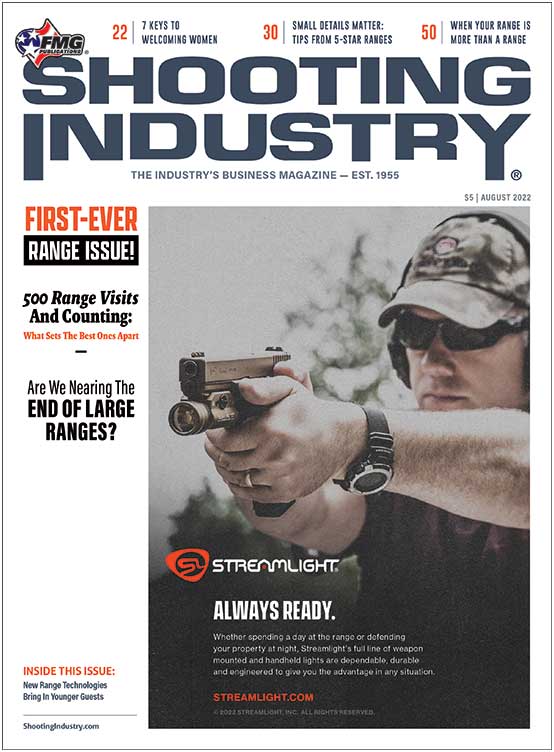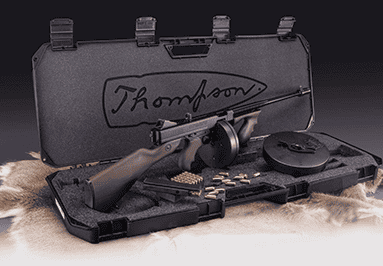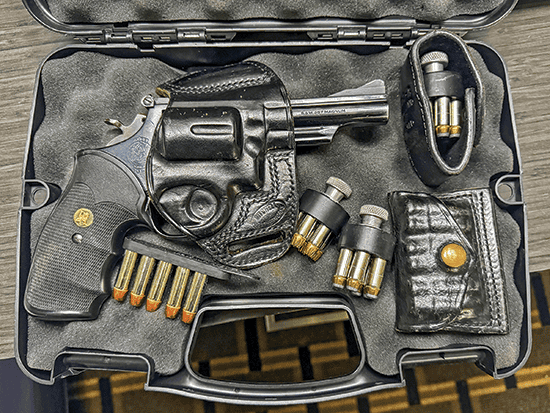Nearing The End Of Large Ranges?
There comes an end to every era, whether you’re an empire, business or both.
At some point, a collective decision (or inaction) will lead to success or demise. The decision point comes on so gradually you might not even notice, but when it’s past the tipping point it’s hard or impossible to reverse. Kodak lasted 120 years before filing for bankruptcy, the Roman Republic pulled off about 500.
Historically, shooting ranges have enjoyed the successes of a growing shooting sports industry marked by the change from rural hunting to urban living and modern recreation. Over the past 30 years the popularity of shooting has been extremely stable, meaning the number of people who go to a range each year to shoot has been very consistent (unlike gun sales trends). 2022 spoiler alert: increased gun sales don’t mean people are actually taking them out of the boxes.
Range Openings Have Slowed, Why?
NSSF does an amazing job of collecting participation data each year and publishes it annually in its Industry Reference Guide, in addition to a tabulation of U.S. ranges from its wheretoshoot.org website.
Taken individually, the industry data looks very promising for an entrepreneurial new range owner — as it shows a stable participation base and growing industry. However, hidden in the data is a longer, more ominous trend indicating the number of indoor shooting ranges opening each year is slowing down as many cities are becoming saturated with ranges.
In other words, the number of shooters who live in a given area only need a certain number of shooting lanes to satisfy demand, just like your neighborhood only needs a certain number of gas stations or Starbucks. For a sprawling city like Atlanta, you could make a claim it would be impossible to saturate — but the numbers are telling.
A Day On A Lane
To better explain this concept, let’s take a step back and study the daily operation of a single shooting lane (yes, one lane, not a whole range). When the range opens, one member might be waiting to get in early and shoot for an hour. Next, a couple comes in to rent some compact pistols to “try before they buy” and another hour passes. Just before lunchtime, two work buddies stop in to shoot for an hour, followed by a retiree trying out his new handloaded ammo.
Using data from NSSF, when you factor in the average shooting session (close to 45 minutes), the average lane occupancy (around 1.6 people per lane) and a 12-hour business day, one lane can serve over 25 shooters per day. For a 10-lane range, this equates to 250 people per day. Here’s where shooting participation becomes important.
The national average participation rate across all age groups is around 5% for target shooting with a handgun. (We selected handguns mainly because it’s most representative of indoor range users.) This percentage is reached by taking the total target shooting (handgun) participants and dividing it by the whole U.S. population.
In 2018, the National Sporting Goods Association (NSGA) reported 14.3 million Americans went target shooting with a handgun out of a U.S. population of 326.8 million (technically 4.4%, but let’s just say 5% for the sake of argument).
So, this means one out of 20 people in the U.S. will visit an indoor range in any given year. If your 10-lane range can support upward of 250 visits per day and you’re open 360 days per year, your total range capacity is 90,000 visits per year.
“We need to adapt to hotter areas (i.e., closer to population centers). Yes, the real estate is expensive and smaller — but it provides access to more people.”
Let’s now move up to a bird’s-eye view. At a participation rate of 5%, one 10-lane range can satisfy the demands of a city with 1.8 million people (90,000 is 5% of 1.8 million). The Indianapolis Metro Area (population 2.1 million), for example, has over 12 ranges, while the San Antonio Metro area (population 2.5 million) has around 20 ranges.
Anyone who hates traffic and values convenience understands more than one range needs to exist in these towns, but the specific placement of these ranges along the urban/suburban divide is getting saturated with the current industry model of building large (greater than 12-lane) ranges.
These large ranges obviously have a sizable footprint, so there’s only a small band around most cities with a reasonable trade-off between real estate expenses and customer convenience. We’re at (or nearing) capacity for most major metropolitan areas in the traditional range placement along this band.
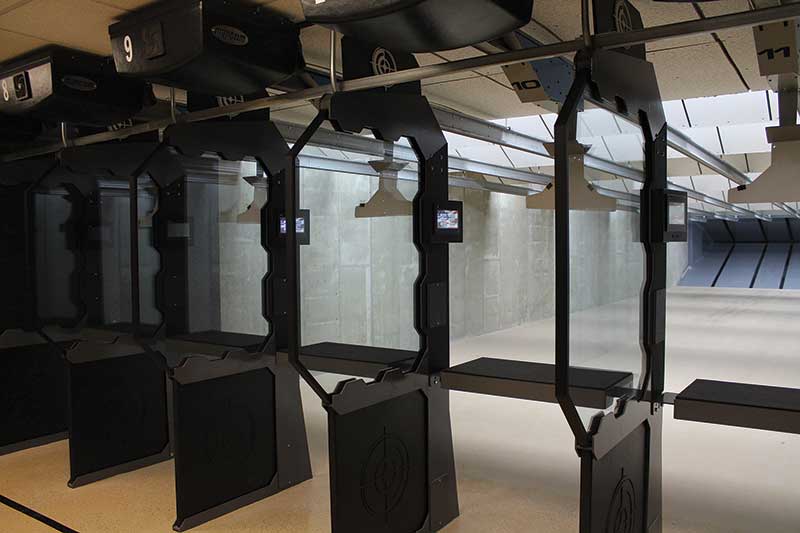
Is the era of expansive indoor ranges over? What are your thoughts on this?
We want to hear from you: comments@shootingindustry.com.
The “Habitable Zone” For Ranges
This trend doesn’t necessarily spell doom for the industry, it just indicates we’re a bit past the tipping point for the traditional large-format range that likes to exist in very specific locations around any given city — let’s call this the “habitable zone,” to take a cue from astronomy. For life to exist on a planet, it has to be far enough away from the sun that it doesn’t burn up, but not too far away it freezes to death; hence a small zone exists where life has the possibility of existing (such as Earth with its abundant sunlight and temperate climate).
The range “habitable zone” is very similar. A large range has to be far enough away from the city center to make the real estate affordable, but not too far away that it’s inconvenient for its customers. This zone typically exists near the outer suburban band of a city if the range was built anytime in the past 10 years.
What we’re seeing in most metropolitan areas is the range “habitable zone” is fully saturated, which is making most potential range owners either waste time scouring for affordable real estate or waste time trying to raise additional money (typically through investors) to afford a more expensive property. It’s a very vicious cycle most potential owners don’t make it through, and the number-one reason we have less ranges opening annually each year.
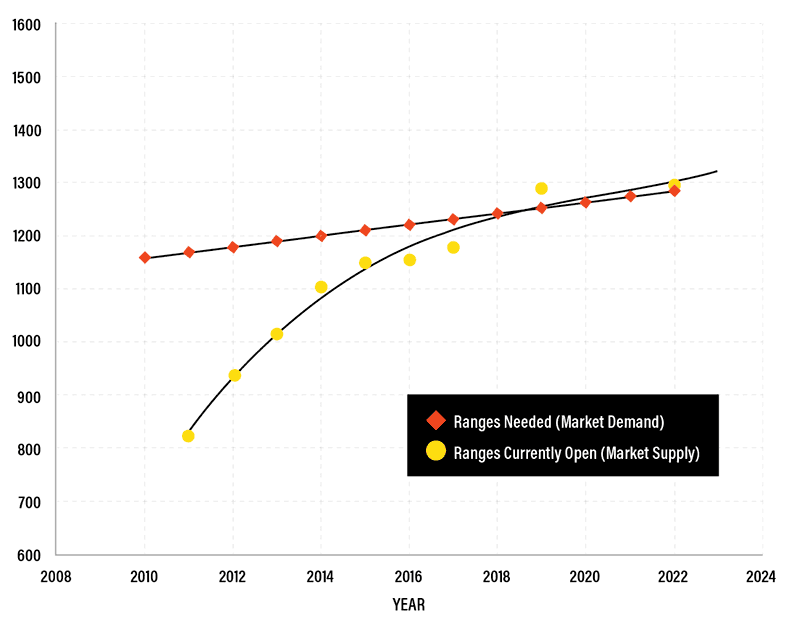
The number of commercial ranges opening annually has been slowing down as many cities
have enough indoor ranges to meet the demand at current participation levels. This trend
is evidenced by the orange line (supply) slowly converging with the yellow line (demand)
based on demographic analysis and annual data provided by Wheretoshoot.org.
The Case For Smaller Footprints
So how can the industry buck this trend? We need to adapt to hotter areas (i.e., closer to population centers). Yes, the real estate is expensive and smaller — but it provides access to more people.
Reading this, you’ve probably guessed the solution already exists — it’s just not as grandiose as the Home Depot-sized guntry club you’ve been planning for the past five years. Enter the small-format range (8–12 lanes) catering mainly to handgun shooters (20 yards or less). These ranges are achieving footprints between around 7,000–9,000 sq. ft. with ease.
With a bit of ingenuity and a focus on recreational handgun shooters, it should be possible to introduce more people to the shooting sports through a handful of smaller ranges placed in convenient locations closer to the population centers.
“ A large range has to be far enough away from the city center to make the real estate affordable, but not too far away that’s inconvenient for its customers.”
With a smaller footprint, the real estate becomes more affordable and abundant. It’s a lot easier to find 9,000 sq. ft. than 20,000 sq. ft., since most retail centers embrace smaller boxes (try testing my theory in a LoopNet search of your area). Anything around 20,000 sq. ft. is either industrial zoned or big-box retail, both of which violate the range “habitable zone” rule (either too expensive or too inconvenient).
With a smaller footprint, you can spend the same amount on real estate as initially planned, but open closer to the population center. Remember, 9,000 sq. ft. at $20/sq. ft. rent is the same as 20,000 sq. ft. at $9/sq. ft. rent.
Overall, the range would benefit from more shooters (higher revenue) and the real estate expenses should be a wash (same operating expense). Anytime you can increase sales revenue without increasing operating expenses, it’s a win at the bottom line.
Convenience Is The Reason
So, what are we getting at here? If you’re a range manufacturer, it’s time to focus on smaller ranges if you want to sell commercial equipment. Sure, your average contract price will be lower, but you’ll make the money up in higher volume and subsequent maintenance deals.
For potential range owners, this is a call to get creative, compact and closer to population centers. In general, you’ll find the small model much more launchable/achievable/graspable/fundable/what-everable.
And for the industry as a whole: the only way to get more people shooting is to make the experience more convenient, period. This usually translates into minimal drive-time from their houses.
B.A. Stear is the founder of Shoot Indoors Franchising LLC, a Colorado-based company that supports a growing number of shooting-range franchises under the Shoot Indoors brand, and the designer of the patented Taper-Range.


